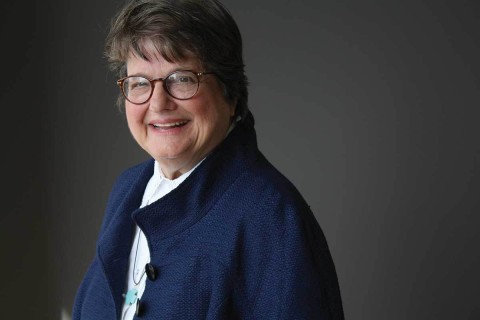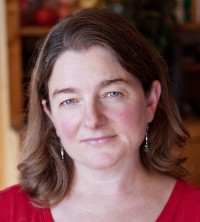How Sister Helen Prejean became a “social justice sister”
“What saves us is learning how to love, even to the point of death.”

Sister Helen Prejean, a member of the Congregation of St. Joseph, is famous for her efforts to abolish the death penalty and for her best-selling 1993 book, Dead Man Walking, which was dramatized in a 1995 film directed by Tim Robbins. She runs an organization called Ministry Against the Death Penalty. Her memoir, River of Fire: My Spiritual Journey, tells how she became a social justice activist. With characteristic candor and humor, she cautions readers to be patient for signs of transformation: “Don’t hold your breath. It’s going to take a while.”
Why did you write a memoir that focuses on your early adulthood and the Vatican II era?
I was in my forties before I realized that the following of Christ, the living of Christianity, is a lot more than praying and asking God to help the suffering people and being nice to the people in my immediate vicinity. It has to do with a wider, deeper framework, and with reaching out to the margins. Less than a sixteenth of a mile away from where I lived as a nun in those times was one of the housing projects where African Americans lived and struggled, with police beating them up, redlined by banks, segregated in neighborhoods, and I was oblivious to it.
Read our latest issue or browse back issues.
This is a condition I am hoping my book can help people wake up to. They will see in the book that I wasn’t a bad person; I was just blind, not exposed. I want to help people wake up.
What are some of the difficulties in getting people to wake up to the injustice of the death penalty?
One is superficial theology about Jesus’ death: “Jesus died for our sins.” I have actually had people say to me, “If Jesus hadn’t died for our sins and been executed by the Romans, we wouldn’t be saved. Therefore I support the death penalty.”
When you dig under that statement, there is an image of God that comes from St. Anselm in the 11th century. He was the first one to offer a juridical model of salvation, in which there had been an offense against the divine majesty of God and only a sacrifice of a divine being, his Son, could satisfy God’s sense of justice. But that is not God; that is an ogre who demands the death of someone.
Another challenge is that very few people get close to the reality of the death penalty. They don’t know that it is a practice of cruelty and torture, the predetermined, deliberate killing of human beings after rendering them defenseless. I have been a witness to six executions. It is unspeakably horrible. But other people don’t see it. There’s a saying from Latin America, “What the eye doesn’t see, the heart can’t feel.”
When I came out of the execution chamber after the first man I accompanied was executed, first I threw up, and then I thought: no one will ever get close to this. Executions are done behind prison walls and then people read about them in the newspaper or see news about them on the television and think, “Look at the terrible crime he did. He was executed. Justice was done.” End of reflection.
If the crucifixion isn’t atonement, how do you understand it?
Jesus suffered the fate of those who have identified with the poor. Like Óscar Romero, like Gandhi, he was seen as threat, and he was taken and killed. What saves us is learning how to love, even to the point of death. Those in the higher realms of authority, even in the church, tend to identify with the wealthy. Jesus showed another way: to love so generously that we could be called to give our lives for others.
What have you learned in your long fight to abolish the death penalty?
Stay in dialogue—face-to-face dialogue. You cannot simply rely on social media or TV or videos. You’ve got to have that personal conversation. That’s why my organization is committed to getting out on the road and talking to people.
For me this has included a long dialogue with my own Catholic Church. Only in August of last year did the Catholic Church state its unequivocal opposition to the death penalty in all instances. The church saw that whenever you turn over to the state the right to put people to death, there is always going to be injustice.
Another thing I’ve learned: use humor. Years ago, when I learned that Alaska was going to introduce the death penalty, I went up there to meet with lawmakers. I had heard that one of the leaders of the charge for the death penalty had on his desk a statue of a man on the gallows. A private meeting was set with him. When I walked into his office, I right away saw that the statue was not there. You can’t go in all dead serious and accusatory. So I said, “I see that little statue you had up there is missing. You know, I have the same little statue on my desk, but I bet we have them for different reasons.” He laughed, and then I was able to talk to him.
When I was working on the film version of the book with Tim Robbins, we would often say to each other, “Change the consciousness, change the culture.” The conversation that we are having about values, about soul, can never be a disembodied conversation. It always has to be brought back to the people who are being excluded, to the people who are suffering. And it has to be done by remaining in real conversation.
What’s your response to the reinstatement of the federal death penalty by the Trump administration?
The federal death penalty is no different in its arbitrariness and capricious application than the ones in the states. For the federal death penalty to be imposed, you have to have a federal prosecutor who wants to go for the death penalty. Federal prosecutors in New York never go for the death penalty, but the ones in Georgia do. Once you see this pattern, it becomes really clear that even the federal death penalty boils down to a few counties and a few federal districts. They’ve never been able to uniformly apply the criteria that the Supreme Court required when it reinstated the death penalty for “particularly serious” crimes.
Nobody knows what that term means. In practice, it means that particularly serious crimes are committed by poor people, and almost always poor people who have killed a white person. When you see the federal death penalty being sought, you know you have a federal prosecutor who is trying to cut notches on his or her political belt.
I’ve been part of trying to get the Supreme Court to abolish the death penalty by showing this capriciousness and demonstrating how keeping a person in a cell for 20 years and then strapping them down and killing them intentionally is torture. We tried to show that the court was not giving weight to the Fourteenth Amendment: people should have equal protection under the law. But the Supreme Court doesn’t look at how the law is actually applied. It has stayed at a theoretical level. Since we are not getting anywhere with the Supreme Court, we are working on changing things state by state.
You often talk about overlooked consequences of the death penalty. What are some of those?
More and more guards are speaking out about the moral consequences of participating in executions. There is a story in Dead Man Walking about a supervisor on death row who was moved to the execution team. He called me into his office after five executions and he said, “Sister, I am not going to make it. I am going to have to quit.” His occupational hazard was that he had gotten to know these people as human beings and then he was being asked to participate in their killing.
There was a warden in Florida who said that he went into prisons believing it to be an honorable profession. He was going to reform prisoners and help them become healthy citizens. Then he got saddled with executions. It only took two executions for him before he quit. He says he will be in therapy the rest of his life. We don’t talk about the moral injury to those who are asked to carry out these executions.
We also don’t talk about the harm to victims’ families. The politicians will always say, “We’re doing it for the victims’ families who are receiving justice.” But families have to wait 15 or 20 years for this so-called justice only to watch the state commit the same violence that has caused their trauma. The death penalty revictimizes families because it forces them into a holding pattern and every time there is a change in the status of the case, the media is on the phone. When New Jersey did away with the death penalty 12 years ago, 52 murder victims’ families testified: “Don’t kill for us.”
In your book, you write about a time when you were on the side of the “spiritual” sisters against the “social justice” sisters. How do you see that divide now?
True spirituality in Christianity, using Jesus as the prism, always flowers into compassion and justice. There is no separation between spirituality and social justice. Jesus made that clear. “I was hungry and you gave me something to eat.”
All religious traditions emphasize the capacity for compassion: to love your neighbor, even at the cost of your own life. No one is excluded from that expansive love. We hope that this is what happens to us in the spiritual life: that we love deeper, we love wider.
For me, being a “spiritual sister” was about passivity. I said to myself, “I am spiritual. I rise above all of that messy politics.” Then I realized that my lack of engagement was an acceptance of the status quo. That too was a political position. You can’t be apolitical.
Then I was moved to action and discovered that it was freeing. You feel that life energy flowing through you. We are meant to act. The path is made by walking.
How do you see the role of Catholic sisters at this moment?
Vatican II taught us that the people are the church. We have to be the ones to live the gospel. The church is not the bishops. It is us. When we are embodying the gospel, we are promoting the health of the church. When we are not doing the gospel, people get hurt. It is not a neutral thing. We have to be in spiritual communities that pray together, reflect on the scriptures, and then act. It’s got to lead to action. That’s where life is.
One thing I love about Jesus is that he never once used the word savior to describe himself. He was always inviting people to be more alive. “I have come that you may have life to the fullest.” The story of the miracles was, “Wake up, get in the pool, get off your mat. Come be alive.”
I recently read this quotation from Goethe, “Be dark to ourselves, open to the outside, and constantly working on the world.” With all of the publicity I’ve received, I have a little experience of what “being dark to ourselves” means. People put things on me, and it makes me very, very uncomfortable. Sure, there is a part of my ego that would like to enjoy the attention for about half a nanosecond, but then it is so unsettling. What keeps me “open to the outside and constantly working on the world” is the fact that I have been with six human beings who have been considered disposable human waste, and I have been with them when they have been killed. I have to get this story out for them. I cannot turn away from being witness to that.
I want to ask about the love story in the book.
You mean me becoming the Bride of Christ—that love story?
Well, I meant the human love story.
I was teasing. It was hard to write about because I wanted to protect the man I called William. I didn’t want him to come off too harshly, because he really was a good man. I knew I had to be careful too. We have a public just ripe for the scandal of it: “Oh, here we go, priests and nuns. Don’t they have a tunnel from the convent to the rectory?”
But he really did love me. It was just that we had such emotional dependence. He would get upset about the smallest things, and then I started organizing my life not to upset him. This happened more and more as his alcoholism got worse. I had eventually to break it off. But it was a good relationship in so many ways. I learned so much from him. We had compatible minds, and we could feed each other that way.
He died a holy man, I believe. He had deep patience and love by then. I wanted people to understand that humans need intimacy. They need closeness. If you are going to write a book like this, you want to talk about the people who are deepest in your life.
A version of this article appears in the print edition under the title “Waking up to the world.”






